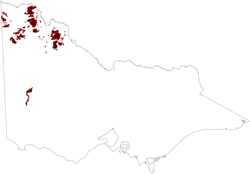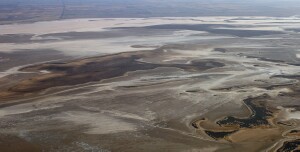5.3 Depressions
5. North Western Dunefields and Plains (DP)
5.3.1 - Groundwater discharge depressions (Lake Tyrrell area, east and west of Sunset Strip)
5.3.2 - Palaeolacustrine depressions (north of Lake Tyrrell, east of Sunset Strip)
5.3.3 - Linear depression (Douglas Depression)
| Distinctive landforms are found in the lower parts of the Tyrrell, Raak and Noora Depressions the margins of which approximate to the 60 m contour. Lacustrine clays remain at or close to the surface of broad plains, whilst specialised landforms have developed where saline groundwaters outcrop. Relatively large lakes which are now saline occur in the Tyrrell Depression, the largest being Lake Tyrrell which is the termination of Tyrrell Creek, an effluent from the Avoca River. Lunettes separate Lakes Tyrrell, Wahpool and Timboram, evidence that the whole area was once inundated. Lalbert Creek, another ephemeral effluent from the Avoca River, terminates at Lake Timboram. The very large Raak Depression extends from the Mildura area to the Raak Plain. From here there is a south-westerly extension on the eastern side of the Millewa Ridge reaching almost to Murrayville. There is another broad extension to the area around Ouyen. A linear arm extends southwards from the Wirrengren Plain along what is now the course of the Wimmera River. The Douglas Depression forms part of this linear feature, which may be an erosional trench caused by overflow from Lake Bungunnia. Most of the Noora Depression lies in South Australia, and its eastern limit is the Millewa Ridge. This limit is indented, apparently marking a shoreline of the former Lake Bungunnia. |  |
| References Macumber, P. G. 1991. Interaction between groundwater and surface systems in northern Victoria. Dept. Conservation and Environment, Melbourne. 345pp Related information on VRO
|  |


